Spring time is feeding time
Plants need energy from food to keep up with the flush of spring growth and now’s the time to give vege gardens and fruit trees what they need to keep them healthy and productive throughout the season. Spring is also key feeding time for hedges, trees and shrubs and flowering plants.
In nature, plants get all their nutritional needs from their environment - from rock minerals held within soil particles built up over millions of years and a continuous supply of decomposing animal and plant matter. In a garden, we remove nutrients every time we harvest so we need to give back what we take away to keep our plants in peak productive health.
Mimicking nature, compost and well-rotted animal manures can meet all plant nutritional needs if added in enough bulk. Adding lots of organic matter also supports heathy soil and home composting is well worth the effort, even on a small scale. But meeting the full nutritional needs of a productive garden solely with compost and animal manures is easiest when there is a good local supply of bulk ingredients.
Garden centres make it easy, offering precision and convenience with a wide choice of plant foods designed to meet the specific needs of the different plant groups. When applied as directed, good fertilisers give fast reliable results without waste. Some release their nutrients gradually in step with plant growth and only need to be applied once or twice in a season. Others provide a quick pick-me-up and are fed in small repeated doses.
Regardless of the plant foods we choose to use, how well our soil and its microbes supply nutrients to plant roots depends not only on the type of soil but how we manage it.
What do plants need?
The NPK on a fertiliser pack represents the relative ratio of three ‘major nutrients’ that plants need in the largest quantities.
Nitrogen (N) is important for leaf growth and converting sunlight into plant energy.
Phosphorous (P) is critical for cell formation particularly in root growth and seedling growth, as well as flowering and fruiting.
Potassium (K) plays an important role in a plants strength, water uptake and disease resistance, and also the quality of flowers, fruits and seeds.
Just as essential, but needed in smaller amounts, are the ‘micronutrients’ (aka ‘trace elements’) including iron, calcium, magnesium, manganese and many more. Plants grow best when they receive all the nutrients they need in the right balance.
What kind of plant food is best?
Regardless of what we feed our soil, how well it holds and releases nutrients to plant roots depends on the type of soil we are lucky enough to have and, most importantly, how we manage it. A healthy soil contains billions of beneficial fungi, bacteria and other soil microbes busily binding soil particles together and transporting nutrients to plant roots. Compost, mulch and bulky manures sustain a soil’s ability to hold water and nutrients, while encouraging earthworms and beneficial microorganisms.
Compost and animal manures, supplemented with homemade fertilisers like comfrey tea, worm tea and fish fertiliser, can meet all plant nutritional needs in a healthy garden. This is easiest when there is a good local supply of free or low-cost material.
By comparison, manufactured fertilisers offer precision and convenience, giving fast reliable results when applied as directed. Many modern fertiliser products are now based on naturally occurring organic ingredients.
Different plants have different nutrient requirements, but luckily for the bewildered home gardener, this is reflected in the wide range of specifically targeted plant foods we have available to us.
Fast acting or slow release?
A fast-acting plant food applied as a liquid or powder (mixed into the soil with water) will provide a rapid boost to growth. Liquid fertilisers are especially useful for plants growing in containers, when applied little and often. Never use powdered fertiliser on potted plants.
Controlled release (aka slow release) fertilisers release nutrients gradually, more in sync with plant growth. Safe to use on container plants, they also allow the convenience of feeding less often while helping to avoid waste and environmental harm though overuse. Some fertilisers combine both fast and slow release action.
Blood and Bone is a natural slow release fertiliser and a source of nitrogen for strong stem and leaf growth plus phosphorus for stem and root development. It is a good source of natural calcium which helps with plant cell strength and a natural soil conditioner.
Nitrophoska Blue is a compound granular fertilser that provides fast-acting and long lasting nitrogen, plus phosphorous and high levels of potassium.
What’s the buzz about seaweed?
Increasingly popular with home gardeners and commercial growers, seaweed extracts are not plant foods on their own, but ‘growth enhancers’ used alongside fertilisers to boost natural plant function.
The magical effect of seaweed has to do with some important plant hormones: auxins for long-wise growth, cytokinins for healthy cell division and nutrient transport, and gibberellins for seed germination, flowering and fruiting.
Applying seaweed to the soil or foliage increases yields and improves the quality of flowers and fruit. It improves resistance to pests and disease and help plants recover quickly when attacked. Seaweed is also used to make plants more resistant to frost and drought.
A fantastic help for vegetable gardeners, seaweed helps to reduce transplanting shock by stimulating rapid root recovery. Soak seedlings with seaweed solution at planting time.
Why lime?
Many gardeners use lime (calcium) to manage soil pH for optimal nutrient uptake. A typical slightly acid to neutral soil (pH 6.0 to 7.5) suits most plants but if the pH gets too low (acidic) or too high (alkaline), plants can have trouble accessing the nutrients they need, even when those nutrients are present in the soil. Adding lime to raise the pH of acidic soil has a positive effect on crops like broccoli and cauliflowers but avoid using it on potatoes or blueberries which need a lower pH. Always apply lime with caution, at the recommended rate.
There are three main forms:
- Ordinary garden lime (calcium carbonate) is made from natural limestone.
- Dolomite lime (calcium magnesium carbonate) raises soil pH more gradually and the magnesium in it is a useful trace element for certain plants, including leafy vegetables.
- Gypsum (calcium sulphate), a natural mineral with a pH of 7.0 (neutral) which can be used to improve soil structure without raising pH. Dolomite lime and gypsum are also used to help with composting.
Feeding vegetable gardens
Vege plants are hungry guzzlers of soil nutrients. What they take from the soil during rapid growth and fruiting needs constant replenishing to sustain future crops.
Quick growing leafy annuals like lettuces were bred to maximise the edible above-ground part of the plant and have smaller roots less able to penetrate deeply into the soil. Hence they need lots of watering and feeding to grow at their best. Fruiting plants like tomatoes, which are bred for high yields, also need a generous supply of nutrients to support prolific fruit production. They soon tell us with lower yields, poor health and inferior fruit if we fail to meet their needs.
While leafy greens consume plenty of nitrogen, fruiting plants like tomatoes and peppers need a higher ratio of potassium. Choose fertilisers to suit your crops needs.
In addition to compost and animal manures, cover crops are excellent soil builders and a good source of nitrogen. The specialised ‘nitrogen-fixing microbes that live in the roots of legume plants (like peas, beans and lupin) turn nitrogen from the air into its plant available form.
Feeding fruit trees
We all know of old fruit trees whose roots are so well established deep into the soil that they fruit prolifically every year without fertiliser. In the main, however, feeding fruit trees in spring delivers healthier trees with better quality fruit, and more of it. Feeding is especially important for young trees and those growing in pots. Citrus are among the first fruit trees to let us know when they need a feed. Yellow leaves and fruit drop are common among malnourished trees.
A complete fruit tree fertiliser provides good nitrogen levels with the right balance of other nutrients. Dried blood and composted (not fresh) chicken manure are good organic sources of nitrogen for fruit trees.
Apply fertiliser evenly at the recommended rate around the trees ‘drip-line’ (under the trees furthest reaching branches), away from the trunk. Rake back any existing mulch beforehand so that fertiliser comes into direct contact with the soil. After feeding, spread a layer of compost or mulch around the tree and water well.
Feeding container plants
Indoors or outdoors, plants grown in pots of potting mix don’t have the advantage of unlimited ground space to spread their roots into. So they need more regular feeding.
Controlled-release fertiliser is best for pots, baskets and planted boxes. This can be supplemented during growth and flowering with liquid plant foods. Avoid powdered fertilisers in containers as these risk burning roots.
Feeding lawns
Lawn grasses are tough but, like any plants, they need regular feeding. A well-fed lawn is not only greener but less weedy than a hungry one as stronger growth will outcompete weeds.
Feed lawns in spring and again in autumn to make the most of the seasonal growth flush. To avoid waste and the pollution that's caused by excess nitrogen leaching through the soil, choose a controlled-release fertiliser or apply small doses regularly. Nitrogen is what a lawn needs most, but a balanced lawn food also contains other important nutrients, including phosphorus for healthy root growth and potassium for disease resistance. Water after feeding, or time it to coincide with a shower of rain.
For a new lawn, choose a suitable lawn fertiliser and apply it at the lower recommended rate. Controlled-release fertilisers feed young grass seedlings without burning. Before sowing, spread fertiliser over the entire area and rake it into the top 2cm of soil. After the first three or four cuts, encourage strong growth with another light application of lawn fertiliser.
On established lawns, compaction and the buildup of dead grass can impede the passage of water and nutrients to lawn roots. An annual ‘dethatching’ with a metal rake and using a garden fork to press holes over the lawn area helps to aerate the soil.

15-Sep-2022

Granule fertilisers
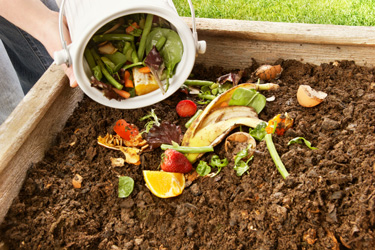
Make compost from kitchen scraps
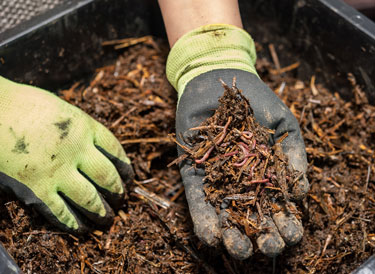
Worm farm
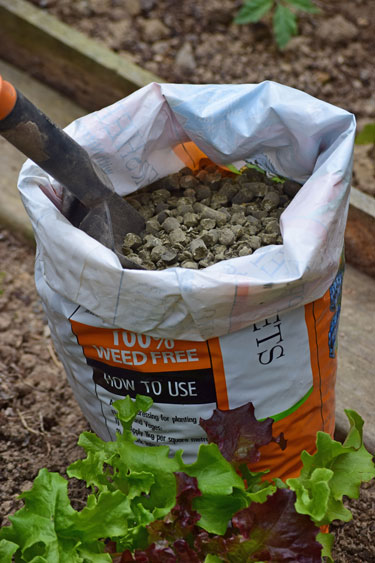
Animal manure in the form of sheep pellets
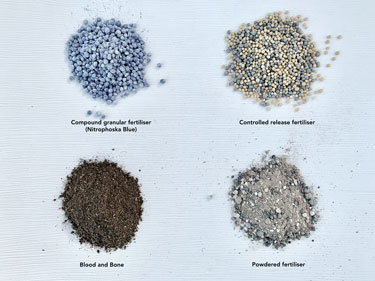
Different forms of fertilisers
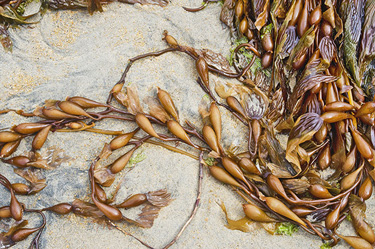
Seaweed

Gypsum granules

